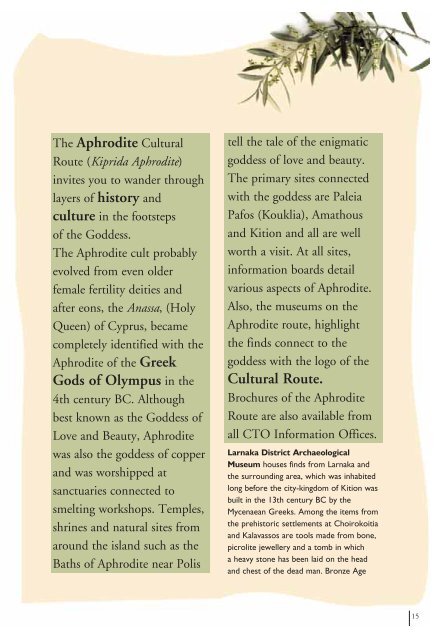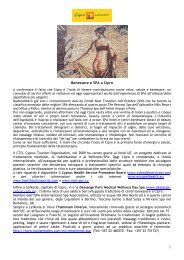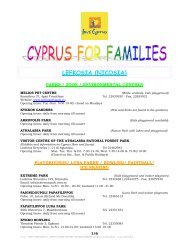Untitled - ente nazionale per il turismo di cipro
Untitled - ente nazionale per il turismo di cipro
Untitled - ente nazionale per il turismo di cipro
You also want an ePaper? Increase the reach of your titles
YUMPU automatically turns print PDFs into web optimized ePapers that Google loves.
The Aphro<strong>di</strong>te Cultural<br />
Route (Kiprida Aphro<strong>di</strong>te)<br />
invites you to wander through<br />
layers of history and<br />
culture in the footsteps<br />
of the Goddess.<br />
The Aphro<strong>di</strong>te cult probably<br />
evolved from even older<br />
female fert<strong>il</strong>ity deities and<br />
after eons, the Anassa, (Holy<br />
Queen) of Cyprus, became<br />
completely identified with the<br />
Aphro<strong>di</strong>te of the Greek<br />
Gods of Olympus in the<br />
4th century BC. Although<br />
best known as the Goddess of<br />
Love and Beauty, Aphro<strong>di</strong>te<br />
was also the goddess of cop<strong>per</strong><br />
and was worshipped at<br />
sanctuaries connected to<br />
smelting workshops. Temples,<br />
shrines and natural sites from<br />
around the island such as the<br />
Baths of Aphro<strong>di</strong>te near Polis<br />
tell the tale of the enigmatic<br />
goddess of love and beauty.<br />
The primary sites connected<br />
with the goddess are Paleia<br />
Pafos (Kouklia), Amathous<br />
and Kition and all are well<br />
worth a visit. At all sites,<br />
information boards deta<strong>il</strong><br />
various aspects of Aphro<strong>di</strong>te.<br />
Also, the museums on the<br />
Aphro<strong>di</strong>te route, highlight<br />
the finds connect to the<br />
goddess with the logo of the<br />
Cultural Route.<br />
Brochures of the Aphro<strong>di</strong>te<br />
Route are also ava<strong>il</strong>able from<br />
all CTO Information Offices.<br />
Larnaka District Archaeological<br />
Museum houses finds from Larnaka and<br />
the surroun<strong>di</strong>ng area, which was inhabited<br />
long before the city-kingdom of Kition was<br />
bu<strong>il</strong>t in the 13th century BC by the<br />
Mycenaean Greeks. Among the items from<br />
the prehistoric settlements at Choirokoitia<br />
and Kalavassos are tools made from bone,<br />
picrolite jewellery and a tomb in which<br />
a heavy stone has been laid on the head<br />
and chest of the dead man. Bronze Age<br />
15










